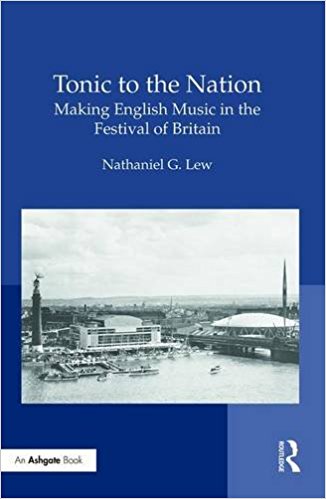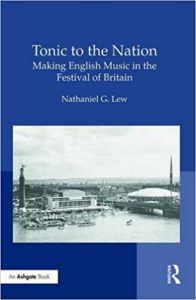

This is part of our special feature on Tourism: People, Places & Mobilities.
From the deprivation that occurred in the aftermath of the Second World War, which ranged from ill-health, rationing, food and housing shortage, to the crushing impact on artistic life, there emerged in Britain an intention to rebuild and improve all aspects of social and cultural existence. It was from this context, of commemorating resilience and celebrating ingenuity, that the 1951 Festival of Britain was planned. Various facets of the Festival, its initial impression on the nation and legacies, have come under academic scrutiny. Becky E. Conekin’s The Autobiography of a Nation: The 1951 Festival of Britain (2003) and Barry Turner’s Beacon for Change: How the 1951 Festival of Britain Shaped the Modern Age (2011) investigate the extensive and innovative cultural and educative programs that flourished a mere six years after the end of the war. As had been the case a century earlier, with the Great Exhibition, the Festival organizers set out to showcase achievements in the fields of science and industry. Just as significant was the emphasis on excellence in areas such as building and design, subjects that are the focus of surveys like Henrietta Gooden’s The Lion and the Unicorn: Symbolic Architecture for the Festival of Britain 1951 (2011) and Harriet Atkinson’s The Festival of Britain: A Land and Its People (2012). The fine arts and performing arts collectively had an equally essential purpose and Nathaniel G. Lew’s new book is a particularly welcome addition to Festival studies. It looks in detail at, and throws much new light on, a crucial aspect of this seminal event.
Lew’s primary aim is to investigate the process that led to the selection of music that was revived for, or written specifically as a result of the Festival. He begins with a contextualization of the 1945-51 Labour government’s attention to the role the arts played in the well-being and education of the people of the United Kingdom. Lew examines the role of the newly chartered Arts Council of Great Britain, an organization that evolved from the Council for the Encouragement of Music and the Arts (CEMA), which helped to bolster the nation’s spirit during the war. Such background detail is informative, and it is also central to his argument, which is to concentrate on the Council’s aims in relation to the Festival of Britain. Lew does not concentrate specifically on composers or their works but “on the roles of the institutions that placed commissions and organized performances” (6). He provides essential background, nevertheless, to several of the key works discussed. The process that leads from commission to performance is rarely without complication, and what is commendable in this study is the way in which the sometimes complex narratives relating to the Council’s plans for concert music and opera are condensed and explained. Ballet performance, we are told, was also a high priority for the Arts Council during the Festival year (109), but that is not part of the focus of this study. The advisory panels and committees responsible for choosing commissions comprised of people who possessed knowledge and judgement, but inevitably problems arose from prevarication over decision-making as well as the tension between the Council’s wanting to foster new music and their concern over its attraction to audiences. Lew gives a balanced account of the Council members’ aims and achievements, as well as the obstacles that beset them.
The first two chapters examine the procedure and policies for formulating a program of music written for the concert stage (including for specific instrumental ensemble, choral, and vocal works) for the London Season of the Arts, the forum for the performing, visual and literary arts. Provision was made for a repertoire of British music from the Renaissance to the present day, although specific reference is made to a dearth of performances of work composed between 1640 and 1880 (an imaginative BBC Third Programme “1851 Week” broadcast the week before the Festival’s opening was one notable exception). The discussion about how and why programs were devised keeps in mind that the Council trod a line between conservative taste and modernism. Lew discloses, however, that the London Season of the Arts proved a greater champion of British music than the BBC through its 1951 Promenade concerts. Through commission, a number of contemporary composers such as William Alwyn, George Dyson, Gordon Jacob, and Thomas Wood fared well, producing music that corresponded with the sense of occasion and national pride befitting the Festival. Yet, attempts to revive the music of other “marginalized” composers like John Foulds, Rutland Boughton, and Havergal Brian, or inclinations to arrange more experimental programs were less conspicuous. Lew raises awareness of the “bureaucratic caution” (52) that tended to stifle some adventurous programing. Despite research into expanding the repertory, the threats of audiences staying away and the potential impact on financial return played a major part in planning decisions. But the Council’s overall achievements should not be discounted, for the quantity of British music featured during the Season was considerable, as can be seen by reviewing a highly useful reference guide, an Appendix that provides a comprehensive list of what, where, and when programs were performed. Another two appendices included in the book note British works commissioned or premiered during the Festival, and a timeline of the open opera commissioning scheme.
Indeed, attention is turned to the operatic stage for the remainder of the book. Any assumptions that commissions from composers who were already part of what might be called the existing musical establishment, such as Vaughan Williams and Britten, was a straightforward exercise are quashed in a detailed examination of obstacles faced by Council and composers alike. Strategic planning and diplomacy were obvious skills that a committee member needed to cultivate. The decision, for instance, over whether Vaughan Williams’s The Pilgrim’s Progress should be premiered at Cambridge Arts Theatre or Covent Garden, and the question of how to avoid offending the composer by not ruling with his preferred choice, is intriguing. So too is the debate initiated by Britten over which opera company was best placed to perform Billy Budd, as well as who was to conduct the premiere. The Council’s prolonged negotiations with Britten to accommodate other of his demands are also documented.
Both of these works have of course found a place in the repertoire, but not all Festival operas achieved lasting success. Lew’s interest in the fate of several works written primarily for the Festival, but since consigned to relative obscurity, provides fascinating reading. George Lloyd’s opera John Socman, a tale of love and deceit set shortly after the Battle of Agincourt, is one of several case studies. Despite Lloyd’s talent and experience in the field (Lew notes the positive critical reception given the composer’s first two operas) it simply failed on this occasion to ignite the interest of everyone in the audience. But we learn of how other dimensions to the story contributed to the opera’s problems, principally the internal discontent within the Carl Rosa Opera company who gave the work its first performance.
At least the Council ensured that Lloyd’s opera made its way to the stage. Initial interest shown in new work did not mean automatic acceptance. For instance, one of the reasons why Peter Tranchell’s operatic adaptation of Thomas Hardy’s The Mayor of Casterbridge was rejected for commission is ascribed to the Council’s concern over both the composer’s and librettist’s (Peter Bentley) youth and inexperience. Tranchell’s work was nevertheless completed and staged to some acclaim at the Cambridge Arts Theatre. By comparison, the Council was clearly worried about the accessibility of an opera such as Brian Easdale’s The Sleeping Children, a “symbolic psychodrama” (100) set against the backdrop of a country school where the children of the title act as a Chorus highlighting both the tension and resolution of the story. Lew’s point, that the work left audiences and critics confused following its premiere by The English Opera Group in Cheltenham, substantiates his claim that one of the Council’s chief goals was to ensure that the Festival of Britain operas that did receive a commission had to balance “modernist ambitions with broad public understanding and appeal” (113).
In view of this, it is interesting to read of other operas that were submitted to the Council for consideration, like Tranchell’s and Easdale’s, by way of open competition. The Council counted “the discovery and development of fresh talent” (117) and, ultimately, the addition of worthy new works to the repertoire of British opera among the objectives of this project. But these ambitions, admirable as they were, proved too demanding. The subcommittee assigned to make selection of entrants failed to envision the sheer size of the task and consequently became caught in a veritable web of regulations. As a result, composers strove to meet certain requirements: the account of Lennox Berkeley having to review the score of Nelson on an almost scene-by-scene basis is one such example. The list of composers who entered the competition (compiled in Appendix 3) suggests that this topic alone would make a stimulating study. Lew refers to a range of works but narrows his focus to Arthur Benjamin’s A Tale of Two Cities, Berthold Goldschmidt’s Beatrice Cenci, Alan Bush’s Wat Tyler and Karl Rankl’s Deidre of the Sorrows. There were mixed results in terms of public and critical reception, and Lew notes which works were broadcast or staged. In the cases of Goldschmidt and Rankl we learn the staggering length of time before a premiere or excerpts were even performed. The question over whether an opera (or a composer for that matter) met the criterion of being “British” enough, the perennial difficulty over finance – of whether opera companies could afford to risk mounting new, untried productions – and, in Bush’s case, nervousness about public opinion over the composer’s politics are among some of the topics that Lew considers.
The final chapter examines how themes running through several of the operas reflected issues that were of both historical and current political significance. As one might expect in an event where recollection of world war was still fresh in the minds of many, notions of heroism and courage were significant themes, as was the toll that conflict had taken both physically and mentally on those returning from war. The content and plot of several Festival operas designedly raised issues to do with identity, of what exactly constituted a “British” story. Lew also offers some pertinent observations about the symbolic role of the opera chorus: a collective, patriotic voice of the people who “[i]n postwar England arguably […] had a deeper national resonance, representing the transfer of the characteristic oratorio chorus into a newly prestigious genre” (163). Just as significant is the reality that in several of these works one witnesses themes of conspiracy, treason and betrayal which foreshadow a new type of actual warfare that would blight the world in time to come. We are reminded that the premiere of Billy Budd, whose plot is built on these same themes, occurred in the wake of the Burgess and McLean spy dramas. Lew’s overview offers some thought-provoking comments on aspects of ‘national elements’ that act as a common thread in these works, all of which, he tells us, are open to further and fuller examination.
This study draws upon evidence from a number of sources. These include Arts Council reports, memoranda, personal and official communication and correspondence from key players involved in the Festival such as Arts Council Music Director John Denison and Assistant Secretary to the Council (and astute writer on music) Eric Walter White. Such comment helps to show the circuitous route that many officials had to navigate as well as the frustration that beset them during their decision making. Additionally, it is just as illuminating to read the impressions of composers who were directly affected by these decisions. We are offered important glimpses into Berthold Goldschmidt’s recollections of the Earl of Harewood’s and Vaughan Williams’s responses to his adaptation of Shelley, and Peter Tranchell’s thoughts on how to shore up dramatic intensity in The Mayor of Casterbridge.
Lew’s argument is lively and interesting throughout, but the book could have benefited from a slightly more rigorous proofread as a small number of typographical errors and lapses in accuracy occur. Edmund Rubbra is re-christened “Edward” ( 64), there’s a mixing-up of Leslie Boosey’s and Ralph Hawkes’s Christian names (79), Peter Tranchell’s adaptation of Hardy is set in an ‘eighteenth-century’ Wessex town (168), and Dickens’s Madame Defarge (from Benjamin’s opera) is called “Lafarge” (174). But small slips do not mar what is an impressively-researched, compelling and highly useful addition to the literature about the Festival of Britain, an event whose legacies in relation to music are evident today through the work that was produced as a result of revival, commission, and the creation of a concert venue (the Royal Festival Hall on London’s South Bank). Lew’s study draws together many details behind the music making that occurred during this momentous occasion. It underlines that despite the bureaucratic drawbacks that it may have created for itself and the problems encountered, the Arts Council demonstrated a genuine desire to bring British music to the nation.
Reviewed by Nicholas Clark, Britten–Pears Foundation
Tonic to the Nation: Making English Music in the Festival of Britain
by Nathaniel G. Lew
Publisher: Routledge
Hardcover / 247 pages / 2017
Published on September 5, 2017.




